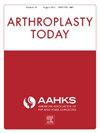Postoperative Pain and Opiate Requirement is Increased Following Second-Side Surgery Among Patients Undergoing Staged Total Knee Arthroplasty
IF 1.5
Q3 ORTHOPEDICS
引用次数: 0
Abstract
Background
Primary total knee arthroplasty (TKA) continues to grow exponentially, with a significant subset of patients requiring staged bilateral procedures. The optimal interval between staged procedures and effective strategies to minimize postoperative pain to enhance rehabilitation and mobility remain poorly understood.
Methods
160 consecutive patients undergoing staged bilateral TKA between August 2017 and January-2021 was retrospectively reviewed. Patients with a history of chronic opioid dependency were excluded. Baseline demographics, primary outcome measures, including visual analog scale (VAS) pain scores, perioperative opioid utilization (MME/day), and surgical satisfaction were evaluated. All patients had a minimum follow-up of 1-year-postoperatively. All univariate and multivariate statistical analyses were performed with significance given by P < .05.
Results
The mean interval between staged TKA was 8-weeks (standard deviation, 4.9-weeks). Preoperative VAS pain scores were significantly higher for the initial TKA, confirming that the more symptomatic knee was addressed first. Despite this, VAS pain scores were significantly increased following second-side TKA at 6-months postoperatively (P = .001). Multivariate analysis identified weekly interval duration between staged procedures as the single-most predictive factor of increased pain following second-side TKA (β = −0.106; P < .01). Female patients were increasingly susceptible to elevated pain levels following second-side TKA (β = 0.372; P = .057).
Conclusions
Postoperative pain increases after second-side TKA in staged-bilateral procedures, despite the more symptomatic side being addressed first. Our study identified weekly interval between staged procedures as the single-most predictive factor of pain, and female patients being predisposed to heightened pain following second-side TKA; implicating nociceptive pathways require weeks to normalize, necessitating gender-specific pain management and extended intervals.
在分期全膝关节置换术的患者中,术后疼痛和阿片类药物需求增加。
背景:原发性全膝关节置换术(TKA)持续呈指数增长,有相当一部分患者需要分阶段双侧手术。分阶段手术之间的最佳间隔和减少术后疼痛以增强康复和活动能力的有效策略仍然知之甚少。方法:回顾性分析2017年8月至2021年1月期间160例连续接受分阶段双侧TKA的患者。排除有慢性阿片类药物依赖史的患者。评估基线人口统计学、主要结局指标,包括视觉模拟量表(VAS)疼痛评分、围手术期阿片类药物使用(MME/day)和手术满意度。所有患者术后至少随访1年。所有单因素和多因素统计分析均以P < 0.05为显著性。结果:TKA分期的平均间隔时间为8周(标准差为4.9周)。术前VAS疼痛评分明显高于初始TKA,证实首先解决了更有症状的膝关节。尽管如此,术后6个月第二侧TKA后VAS疼痛评分显著升高(P = 0.001)。多变量分析发现,分期手术之间的每周间隔时间是第二侧TKA后疼痛增加的最单一预测因素(β = -0.106;P < 0.01)。女性患者在第二侧TKA后越来越容易出现疼痛水平升高(β = 0.372;P = .057)。结论:在分阶段双侧手术中,尽管首先解决了更有症状的一侧,但第二侧TKA术后疼痛增加。我们的研究确定分期手术之间的每周间隔时间是疼痛的最单一预测因素,女性患者易在第二侧TKA后加剧疼痛;暗示的伤害通路需要数周的时间才能正常化,需要针对性别的疼痛管理和延长的间隔。
本文章由计算机程序翻译,如有差异,请以英文原文为准。
求助全文
约1分钟内获得全文
求助全文
来源期刊

Arthroplasty Today
Medicine-Surgery
CiteScore
2.90
自引率
0.00%
发文量
258
审稿时长
40 weeks
期刊介绍:
Arthroplasty Today is a companion journal to the Journal of Arthroplasty. The journal Arthroplasty Today brings together the clinical and scientific foundations for joint replacement of the hip and knee in an open-access, online format. Arthroplasty Today solicits manuscripts of the highest quality from all areas of scientific endeavor that relate to joint replacement or the treatment of its complications, including those dealing with patient outcomes, economic and policy issues, prosthetic design, biomechanics, biomaterials, and biologic response to arthroplasty. The journal focuses on case reports. It is the purpose of Arthroplasty Today to present material to practicing orthopaedic surgeons that will keep them abreast of developments in the field, prove useful in the care of patients, and aid in understanding the scientific foundation of this subspecialty area of joint replacement. The international members of the Editorial Board provide a worldwide perspective for the journal''s area of interest. Their participation ensures that each issue of Arthroplasty Today provides the reader with timely, peer-reviewed articles of the highest quality.
 求助内容:
求助内容: 应助结果提醒方式:
应助结果提醒方式:


